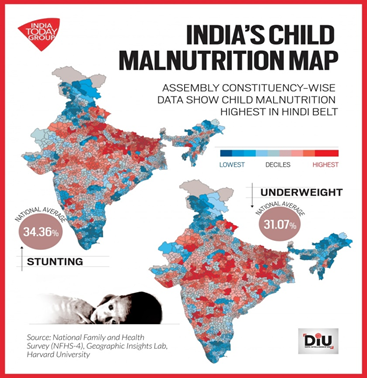

11th October 2022 (8 Topics)
Context
Recently, the Madhya Pradesh government has faced criticism amid the translocation of Cheetah to Kuno sanctuary where there exists more than 50% of the children malnourished over the Districts of Sheopur and Morena.
- This highlighted the ignorance by the government and inappropriate allocation of funds.
|
Malnutrition, in all its forms, includes under nutrition (wasting, stunting, underweight) inadequate vitamins or minerals, overweight, obesity, and resulting diet-related non-communicable diseases. |
About
What are the criteria for measuring malnourishment in India?
There are three main indicators of malnutrition:
- Stunting (low height-for-age): Calculation is based on height-for-age. It is is associated with an underdeveloped brain, poor learning capacity, and increased nutrition-related diseases.
- Wasting (low weight-for-height): It is associated with decreased fat mass. Also known as wasting syndrome, it causes muscle and fat tissue to waste away.
- Being underweight (low weight-for-age): It is a body weight considered to be too low to be healthy. It can reflect both stunting and wasting.

Data analysis of NFHS-5:
- As per the NFHS-5, 35.5% of children below five years were stunted and 32.1 per cent were underweight in 2019-21.
- Among the stunted children, 37.3% are in the rural areas as compared to 30.1% in urban areas.
- At state-wise data, Meghalaya (46.5 per cent), Bihar (42.9%), Uttar Pradesh (39.7%), and Jharkhand (39.6%) have the highest rates of stunting while Sikkim (22.3%) and Puducherry (20%) have the lowest.
Status of Nutrition coverage in India
- India has long been home to the largest number of malnourished children in the world.
- The highest levels of stunted and underweight children are found in Jharkhand, Bihar, Madhya Pradesh, Gujarat and Maharashtra. Some progress has been made in reducing the extent of malnutrition.
- United Nations World Food Programme (UNWFP) paints a picture of hunger and malnutrition amongst children in large pockets of India.
- The report shows the poorest sections of society caught in a trap of poverty and malnutrition, which is being passed on from generation to generation.
Prevalent Reasons of Malnutrition in India
- Lack of adequate initial nourishment to Mothers during Pregnancy.
- Lack of timely availability of Nutrients to growing children especially before the age of 5.
- Less inclusive government policies.
Impacts
- Slow development of brain, weight and bodily functions.
- Future health consequences.
- This in turn affects the child’s ability to learn at school, leading to a lifetime of poverty and lack of opportunity.
- These disadvantaged children are likely to do poorly in school and subsequently have low incomes, high fertility, and provide poor care for their children, thus contributing to the intergenerational transmission of poverty.

